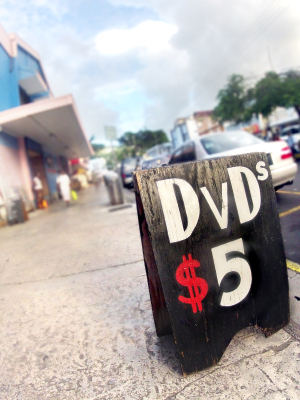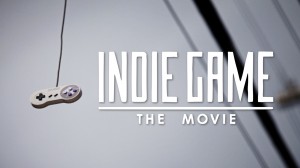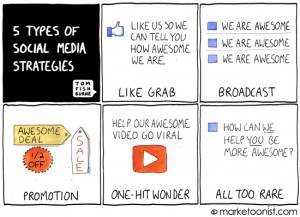
Considerations BEFORE signing over your film’s home video rights
Although DVD distribution revenue has by all accounts declined significantly since the start of home video and the development of the format, most film distributors still distribute DVDs. Sales are down, but there are profits to be had for more commercial or popular fare that is strongly supported with marketing spend, whether studio, indie, or niche.

We always advise filmmakers to conduct Direct Distribution of DVDs to their audience even when we or someone else is handling licensing deals for them. Often though, if a distributor takes on Home Video (i.e. DVD), the expenses associated with the release and the diminishing revenues are the explanation for why digital rights must be licensed to the distributor along with the rights to release the film on traditional physical formats. Digital rights, at least many of them, rightly belong in the home video category,but here’s the rub. While the distributor has more money and more connections and ability to get a DVD into retail stores, they likely take a bigger commission on digital platform sales than an aggregator who is paid a flat fee or a smaller percentage. Of course, even direct digital distribution (streaming from your own site) requires some service or other that takes a fee. It’s just usually less costly than a conventional distributor’s fee. Back to the rub.
So a well heeled distributor gets a big retailer to order your DVDs when you could not have achieved that on your own and probably more money is spent marketing it than you ever could afford to spend. But note that’s also more money to be recouped before you see a return. The DVDs that don’t sell come back. And what comes back gets credited. It should be noted, many conventional distributors take their sales fee off of initial sales, regardless of returns.
So the distributor has the muscle to move the units to a retailer, but not enough muscle to get the public to buy them. They did their best, and even risked their expenses and time and staff energy. But the units come back just the same. Their sales fee is calculated off the top and the net left over for the filmmaker can be paltry. You may or may not be worse off than having done all the distribution yourself.
It is something to think about before you push for traditional distribution where there is not a big enough advance, or none, to recoup your initial investment in the project and you might have been better going it alone, still holding the rights over your film. These things are indeed a calculation of your time and money vs the distributor’s. At least check your contract for language that allows the distributor to keep the sales fee even for the sum of sales attributed to units ultimately returned and refunded. Perhaps compare potential results. Insist on a direct distribution clause so at least you have the chance to make the direct sales to the fan base you have worked so hard to build on your own. Or get clear about what your distributor can do for you that you cannot do for yourself, if anything, and what that is worth to you. Then make sure the contract comports accordingly.
Orly Ravid May 2nd, 2013
Posted In: Distribution, DIY, Marketing, Retailers
Tags: direct distribution, DVD distribution, home video sales, independent film distribution, Orly Ravid, The Film Collaborative
Premiere to Release-Why does it take so long?
Written by Orly Ravid
Now that Sundance has announced its new line up, it seems appropriate to discuss the issue of a film’s distribution after premiering or acquisition at festivals.
It is often the case that films do not get released until 6 months to a year or even more from when the film had its festival premiere…At least this is the case when traditional distribution is pursued as opposed to planning the distribution and marketing to coincide with the premiere and work off that plan accordingly.
Here are 10 reasons for the delay in time between a premiere launch at a festival and traditional distribution into the marketplace:
1. The time it takes to find buyers. These days the market cycle is longer than it’s ever been. Sometimes even a year after a festival or market, sometimes longer to sell titles. It’s a buyer’s market, so few films enjoy the pleasure of contested bidding that forces prices up and faster closings. Sundance, of course, is one of the few festivals that commands such a dynamic and more films than at most other festivals will secure distribution, at least domestically, as a result of premiering there.
2. Once a deal is closed, then there’s the contract and delivery which takes time… months sometimes.
3. Long lead times for press are required, at least four months, and that planning usually does not happen until after deal closure.
4. The distributor needs time to find open slots/appropriate slots in the calendar for theatrical – and it’s competitive out there so getting a booking takes time, and getting the right one for the film takes even more time, again, months. Sometimes even 6 months is needed to book the right theatre for the right time.. Some of the best screens are locked in well in advance.
5. Cash flow is needed to launch marketing campaigns. This can be an issue for some distributors. Recouping some revenue from previous releases will be needed in order to fund future ones.
6. Major digital outlets take several months to upload and make a film available. Cable VOD has solicitation windows. DVD and digital also require set up times and announcing the title and marketing it ahead of time so again months of planning and slotting. One wants to be strategic about release time.
7. The time of release is sometimes specific to the film. It may be theme driven and demand specific timing or it may want to avoid direct competition. Also inventory shifts in retail stores dictate the optimal time for DVD release (ie. certain times of year, like Christmas or Halloween, call for more of a certain kind of film).
8. Internal scheduling of the distributor. As you know, distributors will have other releases that they need to navigate given what their key outlets have planned.
9. Grass roots and other marketing also demand lead time.
10. Overall, the difference between DIY and traditional distribution is that in DIY, you can plan months in advance to set up the outlets and use the press attention at a festival premiere to catapult the film into the market, even if you aren’t 100% sure which festival will be your premiere. Having everything in place to pull the trigger when you get that acceptance puts you in a good position to release. In traditional distribution, the distributor cannot do advance planning and so the planning starts after the initial buzz has been created at the festival.
I know some of you have been confused or frustrated by the lag time between a festival premiere of a film and the release. Hopefully this helps to explain the matter.
Orly Ravid November 30th, 2012
Posted In: Distribution, Film Festivals, International Sales, Uncategorized
Tags: cable VOD, DVD release, film distribution, film promotion, film sales, independent film premiere, independent film release, Sundance Film Festival, theatrical release, traditional film distribution
One key point on film sales
In light of the American Film Market just wrapping up and Sundance on the horizon, we thought we would devote some time to explaining how film sales works and what the landscape is looking like for independent films at the moment. Many of you may not truly be aware of how a sales agent relationship works. Indeed, by conversations we’ve seen on forums and in social media spaces, many newer filmmakers do not understand the repercussions of signing a sales agent agreement for their films.
Typically sales agents do not act like real estate brokers, but more like intermediary distributors. What I mean is they do not facilitate a deal that a filmmaker does directly with third parties and then charge a commission that gets paid out as does a real estate broker. Typically, sales agents first license all the rights from a filmmaker (meaning they then possess all the rights, meaning the film isn’t yours to control during their agreement term) and then re-license them per territory or in a worldwide deal depending on the territory they have been assigned to sell in contractually. The agreement is between the agent and the buyer, not between the filmmaker and the buyer. Often sales agents’ terms are 20 years, or 15, 12, 10, 7, but rarely less than 7 and the more old school ones are longer. The reasoning is that they need the rights to be able to sell the rights. So for at least 7 years, the film is no longer in your possession and by the time you get control of it again, it is indeed considered an old title.
There are some advantages to working with a sales agent of course. They will spend money traveling to markets, producing sales materials, courting buyers and they handle all delivery and oversee the distributors they’ve signed agreement with, keeping a watchful eye and monitoring accounting. Sales agents usually have better buyer contacts than most filmmakers and more leverage, and they have more market intelligence. Bear in mind that they front this money for the film (that they own for a time), but it all must be recouped from the sales revenue with sales commission before any is passed back to the filmmaker. There are also times when the delivery items (also known as deliverables in a sales agent agreement) must be completed and paid for BEFORE the agent will take it out to buyers. In some cases if this hasn’t been delivered upon signing the agreement, an agency may pay to have these items fulfilled if they find a buyer who requires them (like 35mm prints) and the deal is large enough to recoup this additional cost plus commission.
The taking rights component is an issue because these agreements last for a number of years and the filmmaker is shut out of much or all of festival distribution and the ability to conduct direct distribution efforts (internet distribution) plus all the rest. I’ve written all this before; and many seasoned filmmakers already know it, but I write it again to remind of one key thing during this AFM/film sales season: DO THE MATH.
At The Film Collaborative we do sales too, sometimes, in a very boutique fashion. We spend little at markets; we sell only certain strands of films that we have lots of experience in handling. We do NOT take rights ever and the deals are, almost always, between the BUYER and the FILMMAKER. Rare exceptions are when we are doing a bulk TV deal and even then filmmakers still have 100% approval and collect within a few days of us having collected from the broadcaster.
There’s more that can be said about the specifics of sales and samenesses v. differences between our model and the traditional one, but the point is to remind of this one key point: Oftentimes the potential deals that a traditional sales agent can do for you and what you can do for yourself or with us are the same, but the math (because of fees and expenses) will net you less.
There are times when certain types of films have a certain sales potential that may be better served by a motivated sales agent who has the cash to augment the deals and can command more and stand better to collect etc. But most of the time, for indies, the deals these days are so few and far between and for such small prices that if one does not pick a company that follows our model, one will get screwed. Sometimes, the screening fee from festival distribution is the same or more than the sales money (yes, screening fees can be negotiated!). Sometimes the benefit of DIY distribution by the filmmaker can net more than an MG on a sale. Sometimes there are no sales. Sometimes the expense recoupments due to a sales agent exceed the sales revenue. So the key is get real sales projections, back up with corroborating information, and DO THE MATH. Admittedly, this is no easy feat these days and sometimes the sales potential isn’t pretty.
Sometimes films represented by veteran agencies do the exact same deals we do, but instead of the filmmaker getting the money directly from the buyers, it passes through a sales agent who recoups expenses and higher fees such that the net is ultimately less to the filmmaker, who cannot even exploit any rights to her own film.
Before signing agreements with sales agents, ask the agent about the sales potential of your film, the one they are asking to represent (and own for a time). Ask to see the projections in writing and analyze that they really are comparable films (genre, actor names, topic, timeframe of the sale should be in the last year or two, not 5 years ago when the film world was very different). Ask about their intentions for marketing your title, beyond designing a one sheet and perhaps a new trailer. Ask how many films they are representing this year at the markets and will your title get its proper attention. Beyond the markets, will your film be promoted in any other way (publication coverage, special screenings, social media outreach, highlighted on their website and in their weekly email blasts)? Think if it will be worth it to relinquish all rights to your film for at least 7 years. Be in reality about the real sales potential of your film, do the math, and make your decisions accordingly.
Orly Ravid November 13th, 2012
Posted In: Distribution, International Sales
Tags: American Film Market, film buyers, film distribution, film distributors, film markets, film sales, film sales agent, film sales agreements, Sundance Film Festival
Distribution of transmedia stories
by Sheri Candler
Lately, we have been getting inquiries on distribution strategies for transmedia projects in the indie film space. While it is my distinct impression that most of these “transmedia” projects are really marketing campaigns built around films and this extra material probably would not have financial value to a traditional film distributor, I want to investigate a bit more on projects that have launched as cross platform stories.
My knowledge about the transmedia space is limited only to what I have read about or heard about through those who have created such projects. Most of these people were hired by studios, game designers, or big corporate brands to create an immersive and interactive story experience often using digital tools and sometimes real world events to sell a product (a film, a game, a TV show, a car, a book, a mobile service etc). Within the realm of those who create these story experiences, there is disagreement about what constitutes a “true” transmedia project. Is it actually transmedia if it serves “the mothership” product as a sales funnel? Is it actually transmedia if it raises awareness and encourages activism for a social cause? Is it actually transmedia if it breaks a story into a million (or less maybe) pieces and spreads it out in satisfying chunks across many different, but interconnected spaces, online and otherwise? Is it actually transmedia if it provides the audience with a way to participate or interact with the story, perhaps offering the ability to influence the story being told?
The wikipedia definition:
“Transmedia storytelling (also known as transmedia narrative or multiplatform storytelling or cross-media storytelling) is the technique of telling a single story or story experience across multiple platforms and formats using current digital technologies, and is not to be confused with traditional cross-platform media franchises, sequels or adaptations. From a production standpoint, it involves creating content that engages an audience using various techniques to permeate their daily lives. In order to achieve this engagement, a transmedia production will develop stories across multiple forms of media in order to deliver unique pieces of content in each channel. Importantly, these pieces of content are not only linked together (overtly or subtly), but are in narrative synchronization with each other.”
No mention of selling other products in this definition, but does it mean it can’t be used in that capacity? “Permeate their daily lives” is an interesting phrase though because it seems to suggest either bringing the story to life around the viewer or allowing the viewer to virtually, if not physically, step into a story being told or to have some life altering experience that would not have happened had they not encountered/participated in the story.
The man who coined the term Transmedia Storytelling, Professor Henry Jenkins, has offered his updated interpretation here.
Over the next few weeks, I will report back with case studies on what I have found through interviews with those who have been through the experience, launched projects into the world and lived to tell the tale. Also, I will review the newest book on the subject by Andrea Phillips called A Creator’s Guide to Transmedia Storytelling. Hopefully, I will find people who are willing to be open about the process and how they succeeded or what they learned for next time. This is a very experimental space where either a lot of money is spent by way of corporate marketing budgets that will only see a return through sales of a product (and usually do not ONLY use a transmedia experience to advertise that product); or through new media funds where there is no expectation of return or favorable outcome; or through very tiny, self funded budgets where producers are gaining experience and expressing their creative ideas while directly interacting with an audience.
Stay tuned…
Orly Ravid October 4th, 2012
Posted In: transmedia
Tags: A creator's guide to transmedia storytelling, Andrea Phillips, Case studies, cross platform, digital storytelling, distribution, Henry Jenkins, independent film, Marketing, multiplatform storytelling, storytelling, transmedia
Experiments in open teaching
by Sheri Candler
As this is the beginning of a new school year for universities and film schools, it might interest you to know that several film and media courses are opening up their syllabi to the outside world. They aren’t just offering a public facing course description, but actually posting the assignments for their students and the reading materials being used in the class so that all may follow along regardless of where you are. No, isn’t the same thing as receiving one on one attention in class, but then again that’s a reason to pay tuition.
It is also interesting to see what tools instructors are using to communicate with students from wikis to Twitter to LiveJournal and Blogger to something I’d never heard of, Elgg, an open source social networking platform.
The following instructors are all on the cutting edge of the issues facing filmmakers right now; not the cameras or editing equipment or scriptwriting or film history, but the changing landscape of the business of entertainment and what it means to be an artist in the 21st century.
Columbia University Film Program
“Building StoryWorlds: the art, craft and biz of storytelling in 21c” taught by Lance Weiler (@lanceweiler on Twitter)
If you have been keeping up at all with latest trend in entertainment, you have probably heard the term Transmedia Storytelling. It was coined by MIT, now USC, professor Henry Jenkins in 2003 to describe the technique of telling a single story or story experience across multiple platforms and formats using current digital technologies. Filmmaker Lance Weiler describes himself as a story architect, someone who creates not one linear tale, but an entire world for his characters to live in and for audiences to participate with them.
In his Columbia course, students and global collaborators will work together to design, build, and produce an immersive storytelling experience. The whole process will be openly documented and released under a creative commons license in an attempt to gain a better understanding of what goes into creating immersive storytelling experiences.
To join in, follow this course curriculum and check his website Building Storyworlds to keep up with the happenings.
University of Central Florida Graduate course “Guerilla Film Marketing” taught by Randy Finch (@randyfinch on Twitter)
This is a graduate seminar about grass roots and non-traditional marketing strategies for film and media products. The emphasis is on unconventional and microbudget interactions with consumers. During the course, students will become familiar with how the new digital economy and social media tools are changing the landscape for filmmakers and other media producers in the twenty-first century. He requires the students to blog about guerrilla marketing and create materials that they might actually use to market their own films or other media projects.
As Randy told me “I am fascinated by the possibilities for New World film education online. It’s a large part of why I blog. In addition to making my own syllabi and assignments available online, occasionally I even write a post exploring how film education might evolve.”
For a look at the syllabus, use this Google Doc and read Randy’s blog for homework assignments.
Brown University
“Open Source Culture” taught by Mark Tribe (@marktribe on Twitter)
This course utilizes a wiki to disseminate the information. Where do we draw the line between sampling and stealing? What does it mean to call a urinal a work of art? This course explores the tension between artistic appropriation and intellectual property law, and considers recent efforts to use open source software as a model for cultural production. With the advent of digital culture spreading across the world at momentary speed, artists today need to be aware of the changing laws, consumer attitudes and ways in which creativity and communication are happening online. These changes affect business models in many industries, but very much in the entertainment industry where there have been attempts to curb audience access to online content deemed infringing on intellectual property.
For a look at the syllabus, go to this wiki page.
This one was taught in 2010 and I don’t know the status of it now, but the syllabus still lives online…
Georgia Tech
“Digital Media and Participatory Culture” taught by Melanie E.S. Kohnen, Ph.D (@_mesk on Twitter)
The course is an exploration of how digital media is used to participate in various aspects of contemporary culture. Examinations of social networks on the internet specifically matters of privacy, identity, and community formation. Also covered, how digital media is used to participate in culture with a focus on remixing, mash-ups, digital video production, and other forms of transforming existing media texts and how copyright regulations impact remix cultures.
For a look at the syllabus and reading materials, go to this online pdf. Even if the class isn’t actively being taught, there is so much one can do self directed.
If you like the look of that course, you may be interested in these on fan fiction and remix culture, .
If anyone would like to point out other film and media courses geared toward the 21st century filmmaker/artists being taught in an open method, please leave them and their URLs in the comments section.
Orly Ravid September 13th, 2012
Posted In: education
Tags: Brown University, Columbia University, educational resources, film school, Georgia Tech, guerilla marketing, Lance Weiler, Mark Tribe, Melanie E.S. Kohnen, open source culture, participatory culture, Randy Finch, remix, storyworlds, University of Central Florida
Tribeca Wrap up
by Bryan Glick
Sandwiched in between SXSW and Cannes, it is very easy to dismiss or overlook the Tribeca Film Festival. Yet, last year’s crop of films included the world premieres of two of the highest grossing documentaries of 2012 Bully and Jiro Dreams of Sushi. However, most buyers seemed much more hesitant to strike this year.
Part of the issue is that Tribeca Films went all out acquiring The Giant Mechanical Man (starring Jenna Fischer and Chris Messina), Sleepless Night (France, estimated budget €2.5m) , Struck By Lightning (with Christina Hendricks and Dermot Mulroney), Booker’s Place: A Mississippi Story (documentary), War Witch (Canada, estimated budget $3.5m), Resolution (estimated budget $1m), Side By Side (documentary, produced by Keanu Reeves) and Death of a Superhero (Germany/Ireland, estimated budget €3.8m) (The latter two premiered at Berlin and TIFF), so most major buyers settled for one title or none at all.
 Outside of Tribeca Films, Sundance Selects and IFC Midnight were among the most active buyers. The latter took US rights to the world premiere Replicas (Canada with Selma Blair and Joshua Close) and US and UK rights for As Luck Would Have It (Spain with Salma Hayek) which premiered at Berlin. Meanwhile, their sister division, Sundance Selects, went for North and Latin America, UK, and Scandinavia rights to The Flat (Germany, documentary) and also grabbed the best narrative film winner Una Noche (US/UK/Cuba with Dariel Arrechaga) for North America. In addition, the fest also hosted the North American premiere of Beyond the Hills (Romania) which they acquired out of Berlin. IFC got in the game with US rights for Knife Fight (Sweden with Jennifer Morrison and Carrie-Anne Moss, estimated budget $7m).
Outside of Tribeca Films, Sundance Selects and IFC Midnight were among the most active buyers. The latter took US rights to the world premiere Replicas (Canada with Selma Blair and Joshua Close) and US and UK rights for As Luck Would Have It (Spain with Salma Hayek) which premiered at Berlin. Meanwhile, their sister division, Sundance Selects, went for North and Latin America, UK, and Scandinavia rights to The Flat (Germany, documentary) and also grabbed the best narrative film winner Una Noche (US/UK/Cuba with Dariel Arrechaga) for North America. In addition, the fest also hosted the North American premiere of Beyond the Hills (Romania) which they acquired out of Berlin. IFC got in the game with US rights for Knife Fight (Sweden with Jennifer Morrison and Carrie-Anne Moss, estimated budget $7m).
The only other distributor to acquire multiple films was Film Buff. They secured digital distribution rights to Knuckleball! (documentary) and US rights to The Russian Winter (US/Russia, documentary)
The star studded Revenge for Jolly (with Elijah Wood, Ryan Phillippe & Kristen Wiig) got US and Canada covered courtesy of Sony Pictures Worldwide and the festival award winning The Revisionaries (documentary) was acquired for North America by Kino Lorber. Cinedigm continued its banner year with US rights to Don’t Stop Believin’: Everyman’s Journey (documentary about the band Journey who hired their new lead singer via Youtube). Another company making their presence known was, Entertainment One, who couldn’t resist getting North American rights for Freaky Deaky (with Christian Slater, Crispin Glover and Michael Jai White, estimated budget $10m). Meanwhile, Strand Releasing paid six figures for North American rights to Yossi (Israel, estimated production budget $500K), continuing a very effective partnership with the popular Israeli filmmaker Eytan Fox. Other films to sell include Whole Lotta Sole (UK, with Brendan Fraser and Colm Meaney) which went to Arc for near seven figures, Room 514 (Israel) was bought for North America theatrical by Film Movement, and Unit 7 (Spain, estimated budget €3.5m) which sold for US Pay TV and VOD to HBO.
Presently, the Tribeca festival arguably does a better job serving as a platform for films that have already been seen elsewhere or have distribution in place. Films that had North American or world premieres, but were bought before the fest include Magnolia’s Jack and Diane (with Juno Temple and Kylie Minogue), a partnership that featured sports themed documentaries sponsored by ESPN Films with Broke, Benji, and Town of Runners, The HBO Doc release One Nation Under Dog, the Netflix exclusive documentary The Zen of Bennett (about singer Tony Bennett), Cinema Guild’s “Planet of Snail (Finland/Japan/Korea), and Fox Searchlight’s box office bomb Lola Versus (with Greta Gerwig and Bill Pullman) which to date has grossed just barely over $250,000 theatrically in North America. Two special release docs Wagner’s Dream (NCM Fathom Events) and Queen: Days of Our Lives (Eagle Rock Entertainment) were also a part of the slate. Another film to sell before the festival was the Morgan Spurlock documentary Mansome, which Paladin acquired for US Theatrical. It has since grossed a very wimpy $36,280 showing that the days of, “Super Size Me” have long since passed.
FINAL THOUGHTS: Several of these deals have only taken place in the past few weeks (though the fest was back in April) and there were fewer than five deals to report during the festival. There is still a lot of value to screening at Tribeca, but it seems it serves more as a pre-launch into the Cannes market. With Tribeca Films buying so many films both before and after the festival, it raises the question of what is there for other buyers? They have also yet to have a film that has broken out both theatrically and on VOD though “Struck by Lightning” has real potential to do strong business.
Conspicuously absent this year was Magnolia Pictures, Oscilloscope, and The Weinstein Company. All of them are based in Manhattan and TWC and Magnolia struck documentary gold with films they bought at last year’s festival. It is doubtful that any of them would jump into the fray at this point, but it does seem to hint that the commercial prospects for films this year at the festival were not perceived to match those of last year’s slate. The festival still has to figure out how to excite the industry in NYC and convince them that they should go to a festival in their own town.
All that said though, the amount of deals shows that the festival is an increasingly good alternative to Sundance and potentially even SXSW.
ADDITIONAL FESTIVAL DEALS
Since the last blog posts about SXSW and Sundance there are a few more deals to report and some DIY movement.
-Sundance saw a number of films announce deals or DIY plans in the past month.
-Wolfe Releasing secured US DVD/VOD rights to the Sundance documentary Love Free or Die. In addition and in partnership with Wolfe, Kino Lorber will handle the film for educational/non-theatrical screenings. It will have its television premiere on PBS stations nationwide as part of the series “Independent Lens.”
– Fellow US Documentary competition title A Place At The Table (It was called “Finding North” At Sundance) was acquired for the US by Magnolia Pictures. They will release in partnership with Participant Media. The deal was negotiated by Josh Braun of Submarine Entertainment.
-Drafthouse films went for Wrong and will release the film in North America in 2013. It is only the third World Dramatic film to get distribution in the states from this years festival.
-Kimstim Films will be releasing Bestiaire theatrically starting October 19th. This makes it the second of the New Frontier films to secure a theatrical release this year.
-Grand Jury Prize winning documentary The House I Live In will be released theatrically by Abramorama with guidance by Cinetic. Snag films has acquired domestic distribution rights to the film.
-Earlier this month, world documentary competition film Big Boys Gone Bananas did a DIY theatrical, Oscar qualifying run in NY and LA.
There are still over two dozen films from this year’s Sundance that have yet to sell or establish DIY distribution. Of those, almost half were in the world dramatic competition section. Still, when compared to other film festivals, its sales numbers are fantastic! Over ¾ of the films that premiered at the festival this year have been acquired or announced plans for DIY distribution.
On the SXSW front, IFC Midnight decided to stick its teeth into The Jeffrey Dahmer Files (Formerly called “Jeff”). They acquired both North American and UK rights. The deal was negotiated by Submarine Entertainment. Producers Distribution Agency is betting on Brooklyn Castle which they will release in the US October 19th. Based on how their first three features The Way (BO gross $4.4m), Exit Through the Gift Shop (BO gross $3.2m) and Senna (BO gross $1.6m) did this should be one of, if not the highest grossing film to come out of SXSW. Finally, Tribeca Films could not say no to Somebody Up There Likes Me (with Nick Offerman). They took North American rights to the SXSW world premiere. The deal was negotiated by Gray Krauss Stratford Des Rochers LLP. Snag Films continues its best of fest approach and acquired domestic distribution rights to Grand Jury Prize documentary Beware of Mr. Baker Abramorama is handling the theatrical.
A full list of sales deals from Tribeca is listed below. Box office grosses and release dates are current as of August 19th.
| Film | Company | Territories | Sales Company | Box Office/ |
| Release Date | ||||
| As Luck Would Have It | IFC Midnight | US and UK | Premiered at Berlin | |
| Benji | ESPN Films | PRE FEST | ||
| Beyond the Hills | Sundance Selects | North America | Wild Bunch | |
| Booker’s Place: A Mississippi Story | Tribeca Films | North America | Greenberg Traurig, LLP | |
| Broke | ESPN FILMS | PRE FEST | ||
| Death of a Superhero | Tribeca Films | $607 | ||
| Don’t Stop Believin’: Everyman’s Journey | Cinedigm | US | ||
| Évocateur: The Morton Downey Jr. Movie | Magnolia | US | Submarine Entertainment | |
| Freaky Deaky | Entertainment One | North America | Paradigm | |
| Jack and Diane | Magnolia Pictures | Worldwide | ||
| Knife Fight | IFC | US | WME INDEPENDENT | |
| Knuckleball | Filmbuff | Digital Distribution Rights | September | |
| let fury have the hour | paladin | |||
| lola versus | fox searchlight | acquired pre fest | $252603 | |
| Mansome | Paladin | US Theatrical | $36,280 | |
| One Nation Under Dog | HBO Doc Films | PRE FEST DEVELOPED | ||
| Planet of Snail | Cinema Guild | US | Bought out of IDFA | $7978 |
| Queen: days of our lives | Eagle Rock Entertainment | PRE FEST ALREADY ON DVD | ||
| Replicas | IFC Midnight | US | Turtles Crossing LLC | |
| Resolution | Tribeca Films | North America | XYZ Films | |
| Revenge For Jolly | Sony Worldwide | US and Canada | UTA Independent Film Group | |
| Room 514 | Film Movement | North America | ||
| Side By Side | Tribeca Films | North America | Justin Szlasa and attorney Marc Simon | $6956 |
| Sleepless Night | Tribeca Films | US | Bac Films | |
| Struck By Lightning | Tribeca Films | US | Traction Media and ICM Partners | |
| The Flat | Sundance Selects | North/Latin America, UK, Scandinavia | ||
| The Giant Mechanical Man | Tribeca Films | US | $7,396 | |
| The Russian Winter | Film Buff | US | ||
| The Visionaries | Kino Lorber | North America | October | |
| The Zen of Bennett | Netflix | Exclusive | bought Pre fest | |
| Town of Runners | ESPN Films | PRE FEST | ||
| Una Noche | Sundance Selects | North America | ||
| Unit 7 | HBO | US Pay TV and VOD | Vicente Canales’ Film Factory | |
| Wagner’s Dream | NCM Fathom Events and the Met | Screened with The Ring Cycle in May | ||
| War Witch | Tribeca Films | US | Premiered at Berlin | |
| Whole Lotta Sole | Arc | US | ||
| Yossi | Strand | North America | Films Distribution partner Nicolas Brigaud-Robert |
NB: In an effort to put these films in a useable context for filmmakers/investors/distributors, we have provided information (when available) on country of origin, notable names involved, and estimated production budget. From this information, one can see where the sales trends seemed to be at the festival.
Orly Ravid August 22nd, 2012
Posted In: Distribution, Film Festivals, Theatrical
Tags: documentary, festival distribution, film distribution, foreign film, independent film, independent film distribution, independent film marketing, Sundance Film Festival, SXSW, theatrical release, Tribeca Film Festival
Indie Game: a distribution case study
This article first appeared on the Sundance Artist Services blog on August 13, 2012
written by Bryan Glick with assistance from Sheri Candler and Orly Ravid
Indie Game: The Movie has quickly developed a name not just as a must-see documentary but also as a film pioneer in the world of distribution. Recently, I had a Skype chat with Co-directors James Swirsky and Lisanne Pajot . The documentary darlings talked about their indie film and its truly indie journey to audiences.
 Swirsky and Pajot did corporate commercial work together for five years and that eventually blossomed into doing their first feature. “We thought it would take one year, but it ended up taking two. I can’t imagine working another way, we have a wonderful overlapping and complimentary skill set, ” said Pajot. “We both edited this film, we both shot this film. It creates this really fluid organic way of working. It’s kind of the result of 5 or 6 years of working together. I don’t think you could get a two person team doing an independent film working like we did on day one. It’s stressful at times but the benefits are absolutely fantastic, ” said Swirsky.
Swirsky and Pajot did corporate commercial work together for five years and that eventually blossomed into doing their first feature. “We thought it would take one year, but it ended up taking two. I can’t imagine working another way, we have a wonderful overlapping and complimentary skill set, ” said Pajot. “We both edited this film, we both shot this film. It creates this really fluid organic way of working. It’s kind of the result of 5 or 6 years of working together. I don’t think you could get a two person team doing an independent film working like we did on day one. It’s stressful at times but the benefits are absolutely fantastic, ” said Swirsky.
According to Swirsky, Kickstarter covered 40% of the budget. “We used it to ‘kickstart’, we asked for $15000 on our first campaign which we knew would not make the film, but it really got things going. The rest of the budget was us, personal savings.” The team used Kickstarter twice; the first in 2010 asking for $15,000 and ended up with $23,341 with 297 backers. On the second campaign in 2011, they asked for $35,000 and raised $71,335 with 1,559 backers.
The hard work, dedication, and talent paid off. Indie Game: The Movie was selected to premiere in the World Documentary Competition section at the 2012 Sundance Film Festival winning Pajot and Swirsky the World Cinema Documentary Film Editing Award . “[Sundance] speaks to the independent spirit. It’s kind of the best fit, the dream fit for the film. Just being a filmmaker you want to premiere your film at Sundance. That’s where you hear about your heroes,” noted Swirsky. “Never before in our entire careers have we felt so incredibly supported…They know how to treat you right and not just logistics, it’s more ‘we want to help you with this project and help you next time.’ It was overwhelming because we’ve never had that. We’ve just never been exposed that,” interjected Pajot
They hired a sales agent upon their acceptance into Sundance and the film generated tons of buzz before it arrived at the festival resulting in a sales frenzy. The filmmakers wanted a simultaneous worldwide digital release, but theatrical distributors weren’t willing to give up digital rights so they opted for a self release. “There were a lot of offers, they approached us to purchase various rights. We felt we needed to get it out fairly quickly and in the digital way. A lot of the deals we turned down were in a little more of the traditional route. None of them ended up being a great fit,” said Pajot.
Several people were stunned when this indie doc about indie videogame developers opted to sell their film for remake rights to Scott Rudin and HBO. Pajot explained, “He saw the trailer and reached out a week or so before Sundance. That was sort of out of left field because it wasn’t something we were pursuing.” Swirsky added, “They optioned to potentially turn the concept into a TV show about game development…As a person who watches stuff on TV, I want this to exist. I want to see what these guys do with it.” The deal still left the door open for a more typical theatrical release. However that was only the start of their plan.
“We had spoken to Gary Hustwit (Helvetica). We sort of have an understanding of how he organized his own tours. We had to make our decision whether that was something we wanted to utilize. Five days after Sundance, we decided we would and were on the road 2 weeks after… Before Sundance this was how we envisioned rolling out…[We looked at] Kevin Smith and Louis C.K. and what they’re doing. We are not those guys and we don’t have that audience, but knowing core audience is out there, doing this made sense,” said Swirsky.
They proceeded to go on a multi-city promotional tour starting with seven dates and so far they have had 15 special events screenings of which 13 were sold out! This is separate from 37 theaters across Canada doing a one night only event. They also settled on a small theatrical release in NYC and LA. When talking about the theaters and booking, they said theaters saw the sellout screenings and that prompted interest despite the fact that the film was in digital release. They accomplish all of this with a thrifty mindset. “P&A was not a budgetary item we put aside and if an investment was required, we would dip into pre orders. We didn’t put aside a marketing budget for it,” said Swirsky. Regarding the pre order revenue, they sold a cool $150,000 in DVD pre-orders in the lead up to release of the film. From this money, they funded their theatrical tour.
While the theatrical release was small, it generated solid enough numbers to get held over in multiple cities and provided for vital word of mouth that will ultimately make the film profitable. The grosses were only reported for their opening weekend, but they continued to pack the houses in later weeks.”I don’t look back at the box office. The tour was more profitable than the theatrical…They both have the benefits, having theatrical it gets a broader audience. It was more a commercial thing than box office,” said Swirsky. “We are still getting inquiries from theaters. They still want to book it despite the fact it’s out there digitally,” said Pajot. “We had this sort of hype machine happening. We didn’t put out advertising. Everything was through our mailing that started with the 300 on our first Kickstarter and through Twitter,” said Swirsky. Now the team has over 20,000 people on their mailing list and over 10,000 Twitter followers. In order to keep this word of mouth and enthusiasm going, the filmmakers released 88 minutes of exclusive content – most of which didn’t make the final cut – to their funders, took creative suggestions from their online forum and sent out updates on the games the subjects of their film were developing over the course of the two years the film was in production.
Following the success the film has enjoyed in various settings, Indie Game: The Movie premiered on three different digital distribution platforms. If you were to try and guess what they were though, you would most likely only get one right. While, it is available on the standard iTunes, the other two means of access are much more experimental and particularly appropriate for this doc.
It is only the second film to be distributed by VHX as a direct DRM-free download courtesy of their, ‘VHX For Artists‘ platform. Finally, this film is reaching gamers directly through Steam which is a video game distribution platform run by Valve. This sterling doc is also only the second film to be sold through the video game service, where it was able to be pre-ordered for $8.99 as opposed to the $9.99 it costs across all platforms. This is perhaps the perfect example of the changing landscape of independent film distribution. Every film has a potential niche and most of these can arguably be reached more effectively through means outside the standard distribution model. Why should a fan of couponing have to go through hundreds of films on Netflix before even finding out a documentary about couponing exists, when it could be promoted on a couponing website?
As they are going into uncharted territory, both Pajot and Swirsky avoided making any bold predictions.”It’s just wait and see. It’s an experiment because we’re the first movie on Steam. We’re really interested to look at and talk about in the future. I don’t want to make predictions…I do think documentary lends itself to that kind of marketing though. We’re trying to not just be niche but there is power in that core audience. They are very easy to find online,” said Swirsky.
Just because they are pursuing a bold strategy doesn’t mean they were any less cost conscious. “The VHX stuff, it was a collaboration, so there were no huge costs. Basically subtitles, a little publicity costs from Von Murphy PR and Strategy PR who helped us with theatrical. Those guys made sense to bring on,” said Pajot. “A lot of our costs were taken up by volunteers. If they help us do subtitles, they can have a ticket event, a screening in their country,” added Swirsky.
They also note that a large amount of their profit has been in pre-orders. 10,000 people have pre-ordered one of their three DVD options priced at $9.99, $24.99 and a special edition DVD for $69.99 tied with digital. While the film focused on a select few indie game developers, they interviewed 20 different developers and the additional footage is part of the Special Edition DVD/Blu-Ray. That might explain why it’s their highest seller.
All this doesn’t mean that any of the dozens of other options are no longer usable. Quite the contrary, they have also taken advantage of the Sundance Artist Services affiliations to go on a number of more traditional digital sites. Increased views of a film even if on non traditional platforms can mean increased web searches and awareness and could be used to drive up sales on mainstay platforms.
The real winner though is ultimately the audience. For the majority of the world that doesn’t go to Sundance or Cannes each year, this is how they can discover small films that were made with them in mind. The HBO deal aside, this is bound to be one incredibly profitable documentary that introduces a whole new crowd to quality art-house cinema. “We are still booking community screenings. If people want to book, they can contact us…We are thinking maybe we might do another shorter tour at some point,” said Pajot.
Here’s to the independent film spirit, alive and well.
Update Feb 2013: The creators of Indie Game have written their own case study discussing the many tools and techniques they used. Head over to their website for the full study.
Orly Ravid August 16th, 2012
Posted In: Digital Distribution, Distribution, DIY, Film Festivals, iTunes, Marketing, Publicity, Theatrical
Tags: crowdfunding, DIY distribution, documentary, game developers, Gary Hustwit, independent film, Indie Game, James Swirsky, Kevin Smith, Kickstarter, Lisanne Pajot, Louis C.K., self distribution, Steam, Sundance Artists Services, Sundance Film Festival, VHX, VHX for Artists
The harsh realities of becoming a *responsible* filmmaker
by Orly Ravid
It is difficult to definitively explain what The Film Collaborative (TFC) does in a few sentences. Often, when asked for a company bio for a speaking engagement, we are asked to sum up in a few words, but here is the thing…we do different things for different films and that is what makes this non profit company devoted to independent film distribution different. We are a membership organization and we offer a menu of services that are separately available. For our members, we are largely an educational and informational organization. We will work with any film/filmmaker to provide consultation and educational resources which are included in our membership fees.
We can provide services such as: worldwide festival distribution, worldwide sales, domestic sales, worldwide direct digital, domestic theatrical, limited domestic educational distribution, grassroots / social network marketing services, and contract negotiation services. These are all subject to additional fees so the filmmaker must have significant budget to allow for the labor and expenses incurred and our acceptance depends on the workload currently undertaken by the company.
We also serve in a sales agent capacity with SOME films. Due to this dual nature (educational and service oriented), we are very discerning about the films we take on in this capacity. We can work on any aspect of distribution, but with a strong emphasis on direct distribution being part of your overall distribution strategy. We can connect you with service providers/buyers we think are right for your film, and ones we trust and recommend, but WE NEVER OWN YOUR RIGHTS and filmmakers can cancel the service at any time. This clearly sets us apart from other sales agents and can be confusing to those who are accustomed to typical sales agent arrangements. The deals we make are almost always between the buyer and the filmmaker. The only exception to this are bulk deals whereby doing the deals individually is just tortuous for all involved. We are very boutique in our sales agent offerings, not wanting to disappoint or take on more than we can handle. If we don’t think a title is suited to our strengths and our mission to offer quality films of artistic merit with strong distribution potential, then we don’t take them on for sales representation. Which brings us to merit…
Not all films will have distribution potential, not all films are good, not all films have an audience, or not a significant one. There, we said it! Time and again we see filmmakers willingly, enthusiastically going into debt, either raising money from investors or credit cards and coming to us for help in getting their creations out into the world. Sometimes those creations just won’t have a life out there and no matter what is spent in time or money, a significant audience won’t be found. We drill down into every member’s film in order to give the best assessment, but there are times when the prognosis is not favorable to the kind of success they are seeking.
For members’ films, we remove our personal tastes from the equation and try our best to determine WHO in the world would be enthusiastic for the film and how many such folks are out there? And where are they? And can they be reached given the resources available? When you made the film, were you thinking of an audience? When you came to us expecting the film to: get TV sales, international sales, a nice Netflix fee, a theatrical release, a theatrical even after you did a DIY DVD and iTunes release, were you basing that on another film that is similar? Do you understand the decision making process involved in the buying of films for release? Was any research at all conducted BEFORE the production started? With the amount of information on our site and thousands of others online, there is no longer an excuse for not knowing the answers to these questions well before a production starts.
I am starting to want to be the tough love nursemaid and say we don’t want your babies to be orphans. Filmmakers now have to educate themselves a bit before conception and well before giving birth so they will be able to cover all the rearing their film baby is going to need to claw its way through the mobs of other film babies, their TV siblings, Webcontent cousins, and the rest of their multimedia distraction family. As with conceiving real babies, it is all fun and games until the reality of raising a child sets in. You need to be fully prepared for the long haul.
We have information, we keep up with the current shifting sands of distribution, we receive opportunities because we represent quality films, we have contacts, years of expertise, we’re friendly, we’re not gonna f*ck you over, but we cannot save every film from oblivion nor can we convert every film into a success however you define it. So much of that has to start with you, being clear and honest with yourself, before you say “action”.
photo credit: Adam Foster | Codefor
Orly Ravid August 8th, 2012
Posted In: Digital Distribution, Distribution, International Sales, Marketing
Tags: artistic merit, consultation, Digital Distribution, direct distribution, educational resources, festival distribution, film distribution, film sales, independent film, non profit, sales agent, TFC







